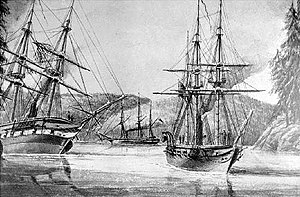 HMS Plumper (right), with HMS Termagant (left) and HMS Alert (background) at Esquimalt in the late 1850s
| |
| History | |
|---|---|
| Name | HMS Plumper |
| Ordered |
|
| Builder | Portsmouth dockyard |
| Cost | £20,446 |
| Laid down | October 1847 |
| Launched | 5 April 1848 |
| Commissioned | 17 December 1848 |
| Fate | Sold for breaking 2 June 1865 |
| General characteristics | |
| Type | Screw sloop |
| Displacement | 577 tons |
| Tons burthen | 490 24/94 bm |
| Length | 140 ft 0 in (42.7 m) gundeck, 121 ft 10.5 in (37.1 m) Keel for tonnage |
| Beam | 27 ft 10 in (8.5 m) maximum, 27 ft 6 in (8.4 m) for tonnage |
| Draught | 11 ft 4+1⁄2 in (3.5 m) mean |
| Depth of hold | 14 ft 6 in (4.4 m) |
| Installed power | 148 ihp (110 kW) |
| Propulsion |
|
| Sail plan | Barque rig |
| Speed | 7.4 kn (13.7 km/h) under power |
| Complement | 100 |
| Armament |
|
HMS Plumper was part of the 1847 programme, she was ordered on 25 April as a steam schooner from Woolwich Dockyard with the name Pincher. However, the reference Ships of the Royal Navy, by J.J. College, (c) 2020 there is no entry that associates this name to this build.[1] The vessel was reordered on 12 August as an 8-gun sloop as designed by John Fincham, Master Shipwright at Portsmouth. Launched in 1848, she served three commissions, firstly on the West Indies and North American Station, then on the West Africa Station and finally in the Pacific Station. It was during her last commission as a survey ship that she left her most enduring legacy; in charting the west coast of British Columbia she left her name and those of her ship's company scattered across the charts of the region. She paid off for the last time in 1861 and was finally sold for breaking up in 1865.
Plumper was the fifth named vessel since it was introduced for a 12-gun vessel launched by Randall of Rotherhithe on 17 May 1794 and sold in January 1802.[1]